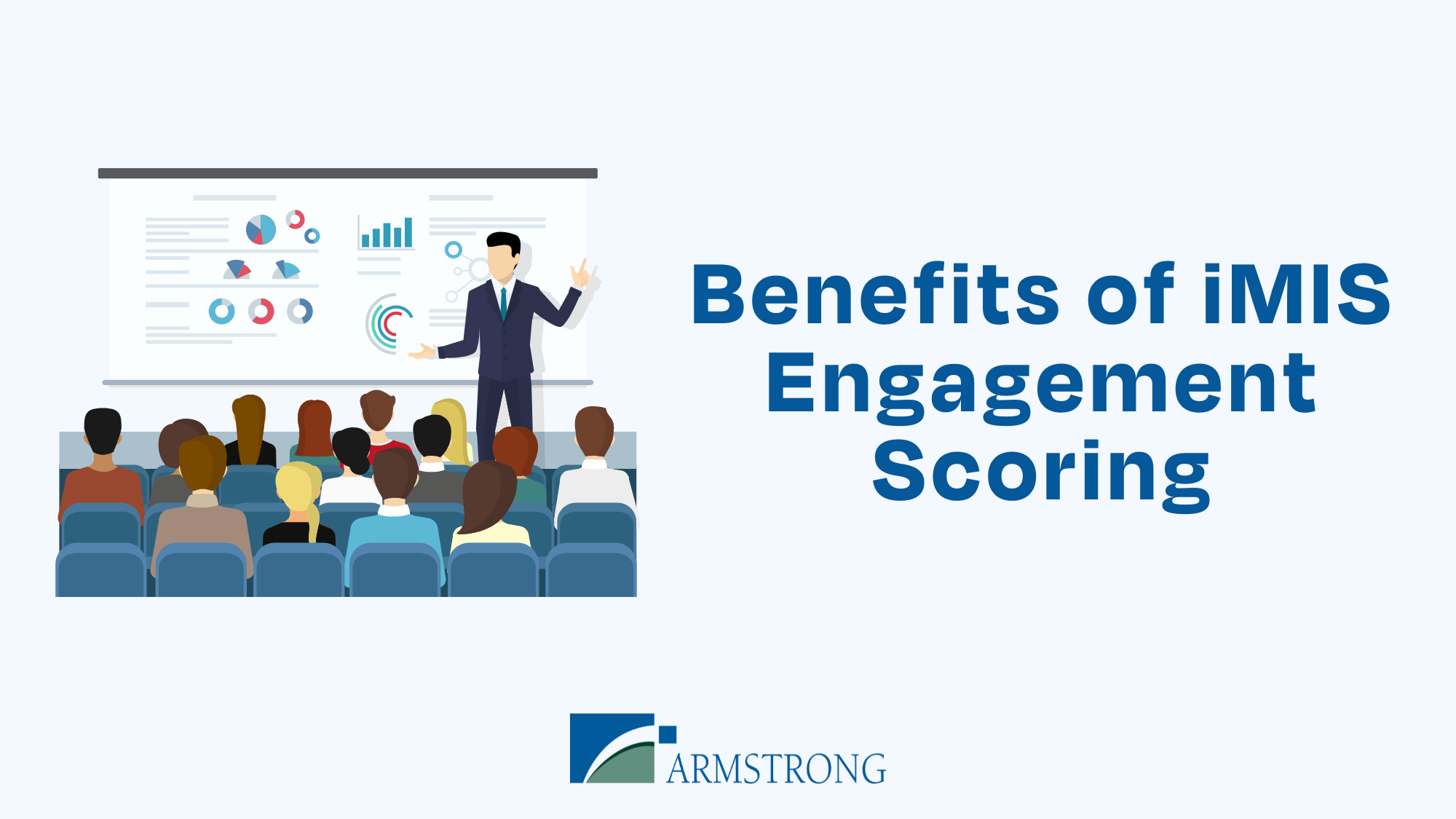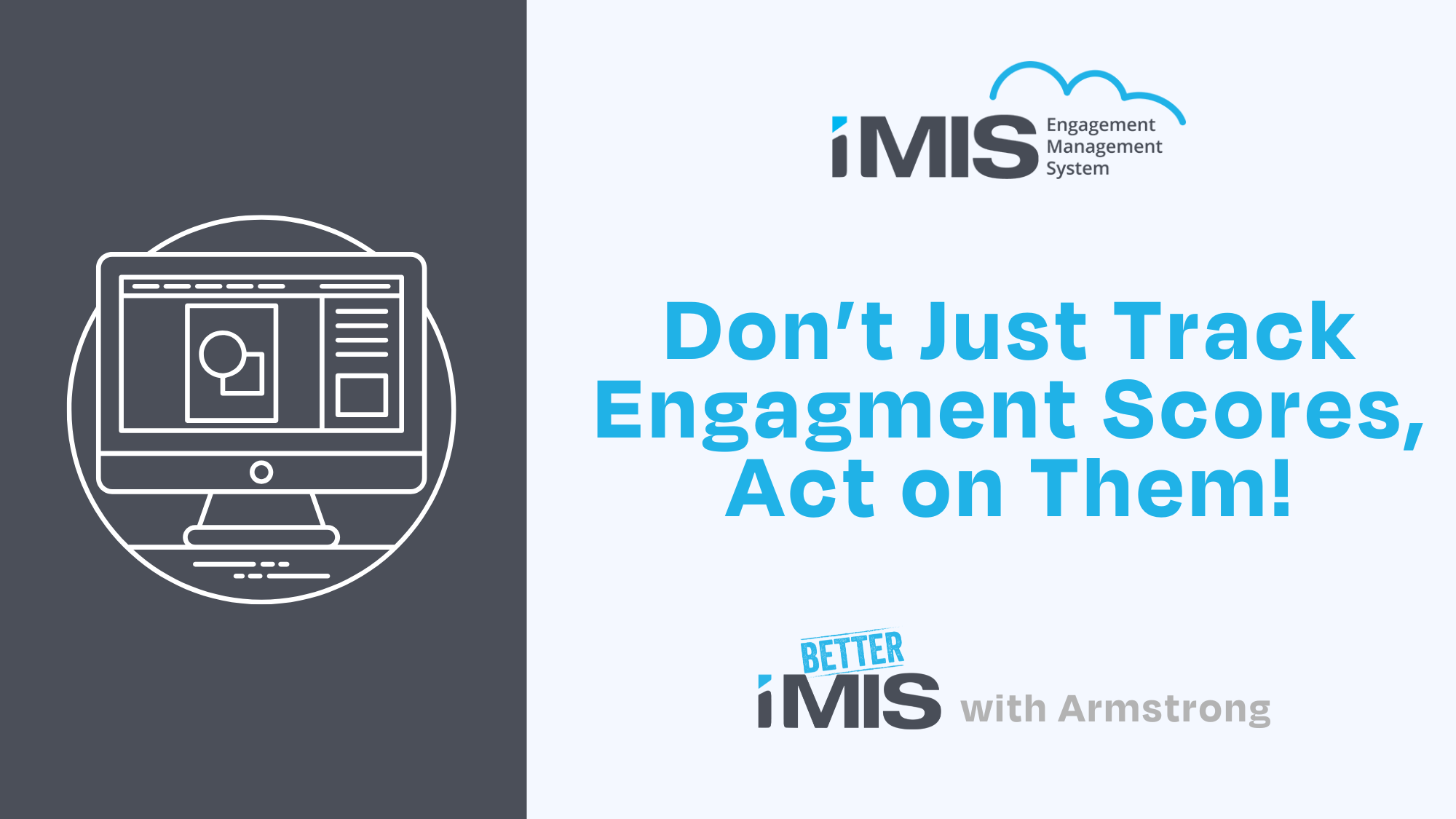iMIS EMS Engagement Scoring: The Complete Guide
It’s called an “Engagement Management System” for a reason. iMIS EMS membership database is designed to help organizations measure, track, and boost engagement with members, donors, and other stakeholders.
At the heart of this system lies the concept of engagement scoring, a powerful tool that reports on how actively individuals or organizations interact with your association.
What is Engagement Scoring in iMIS EMS?
Engagement scoring allows your organization to assign numerical values to various member activities, providing a clear picture of how engaged each member is.
Scores offer a quantifiable measurement of member involvement, making it easier to identify highly engaged members and those who might need a nudge to participate more actively.
Key Components of iMIS Engagement Scoring
At the core of iMIS engagement scoring are the score components, which are the individual activities and interactions that collectively define how engaged a member truly is.
Common components you can track and assign value to include:
- Event Attendance: Participating in conferences, workshops, webinars, and other events.
- Product Purchases: Buying publications, merchandise, toolkits, or other association resources.
- Donations: Making financial contributions to support your programs, scholarships, or initiatives.
- Committee Participation: Actively serving on committees, task forces, or working groups.
- Volunteer Hours: Donating time to association projects, leadership roles, or community service activities.
- Online Community Participation: Engaging in discussion forums, special interest groups, or member communities.
- Email Opens: Interacting with association emails by opening newsletters, event invites, or targeted campaigns.
- Website Visits: Logging into your member portal, exploring resource libraries, or accessing other online tools.
Each of these activities can be weighted differently based on their importance to your engagement strategy—giving you a flexible, holistic view of how connected and active each member really is.
Multipliers: Not all activities are created equal. Multipliers allow organizations to assign different levels of importance to each activity. For instance, attending an annual conference might be deemed more significant than downloading a newsletter, and with that, assigned a higher multiplier.
Score Calculation: iMIS provides flexibility in how scores are calculated for each component.
Organizations can choose between:
- Count: Tallying the number of times an activity occurs (e.g., number of events attended).
- Sum: Aggregating the total value associated with an activity (e.g., total donation amount).
Categories: Once scores are calculated, members can be grouped into categories based on their engagement levels. This stratification helps in tailoring communication and strategies for different member segments. Typical categories include:
- Leader: Highly engaged members who participate in multiple activities regularly.
- Contributor: Members with moderate engagement, actively involved in specific areas.
- Participant: Members who engage occasionally but not consistently.
- User: Members with minimal engagement, possibly at risk of disengagement.
Implementing Engagement Scoring in iMIS
Setting up engagement scoring in iMIS EMS involves a systematic approach:
- Define Engagement Activities: Identify which member interactions are most valuable to your organization. This could range from event participation to content downloads.
- Develop IQA Queries: Use iMIS’s Intelligent Query Architect (IQA) to create queries that capture data for each defined activity. For example, a query might track all members who attended events in the past year.
- Assign Multipliers: Determine the relative importance of each activity by assigning appropriate multipliers. This ensures that more impactful activities have a greater influence on the overall engagement score.
- Create Scoring Formulas: Combine the IQA queries and multipliers into a cohesive scoring formula. This formula will calculate each member’s engagement score based on their activities.
- Calculate and Review Scores: Run the scoring calculations to generate engagement scores for all members. Regularly review these scores to monitor trends and identify areas for improvement.
- Display Scores: Utilize the Engagement Score Display content item in iMIS to showcase scores on member profiles or dashboards, providing both staff and members with insights into engagement levels.

Benefits of iMIS Engagement Scoring
Implementing engagement scoring offers numerous advantages:
- Data-Driven Decision Making: With clear engagement metrics, organizations can make informed decisions about programs, events, and member services.
- Targeted Communication: Understanding engagement levels allows for personalized communication strategies, ensuring members receive relevant content and opportunities.
- Member Retention: By identifying members with low engagement scores, organizations can proactively reach out to re-engage them, reducing churn.
- Resource Allocation: Insights from engagement data help in allocating resources effectively, focusing efforts on initiatives that drive the most value.
Challenges and Considerations of Engagement Scoring
While engagement scoring is a powerful tool, it’s essential to approach it thoughtfully:
- Data Accuracy: Ensure that all member interactions are accurately recorded in iMIS. Incomplete or incorrect data can lead to misleading scores.
- Regular Updates: Engagement is dynamic. Regularly update scores to reflect recent member activities, providing an up-to-date picture of engagement.
- Member Privacy: Be transparent with members about how their data is used for engagement scoring. Ensure compliance with relevant data protection regulations.
- Avoid Overemphasis on Scores: While scores are insightful, they shouldn’t overshadow qualitative aspects of member engagement. Use them as one of many tools to understand and enhance member relationships.
Real-World Applications
Here are a few examples of how you can leverage iMIS’s engagement scoring:
- Career Centers: By integrating career center activity with iMIS, your association can track job board interactions, applications, and employer engagements—adding depth to engagement scoring that reflects professional development interest.
- Online Learning Platforms: Tracking who registers for, completes, or interacts with your educational content (courses, certifications, webinars) can become a goldmine for understanding how invested members are in their own growth.
- Advocacy Actions: Associations can also track involvement in grassroots campaigns, letter-writing efforts, or policy actions. Even if a member rarely attends events, their advocacy involvement may place them in a highly engaged category.

How to Use Engagement Scores for Action
Here’s where it gets fun: once you’ve set up your engagement scores, you can actually do something with them. And this is what separates iMIS from a generic CRM or AMS—it doesn’t just store data, it helps you act on it.
Some practical ways to use engagement scores:
- Tailored Campaigns: Send more exclusive, high-touch opportunities to your most engaged members like early access to events, speaking invitations, or leadership programs. Conversely, target lower-engaged members with re-engagement campaigns, simple surveys, or quick “What’s new at our org” updates.
- Member Journeys: Use scores to help automate pathways. For example, when someone hits a certain engagement threshold, you can trigger an automated message that says, “You’ve been active in three areas, do you want to get even more involved?”
- Predictive Retention: Scores can help flag at-risk members before they lapse. If you know the average score of members who renew is, say, 65, then members trending below 30 might benefit from outreach or a personalized check-in.
- Board Reports That Actually Say Something: Let’s face it, boards don’t want to hear about how many emails you sent. They want impact. An engagement scoring model gives you real data to show how your programs are moving the needle.
Why Engagement Scoring Matters Now
We’re all feeling it: inbox fatigue, content overload, digital noise. Engagement scoring cuts through the chaos by giving you a clear picture of who’s really with you—and who’s drifting.
Even more importantly, it shifts the mindset from reactive to proactive. Instead of waiting until someone stops renewing or attending events, you can spot trends and take action while the relationship is still salvageable.
In short: engagement scoring isn’t just a data exercise. It’s a relationship management strategy.
Why iMIS AMS Makes This Easier
You could try to cobble this together manually—pulling spreadsheets from your event platform, CRM, email tool, and LMS—but let’s be real: that’s a full-time job, and by the time you’ve got the data, it’s outdated.
iMIS is purpose-built for associations and nonprofits. Its engagement scoring tools aren’t bolted on, they’re baked in. That means you can automate calculations, customize what counts as engagement, and see trends over time, all from one place.
When implemented well, it becomes a central nervous system for your organization—helping every department, from marketing to membership to education, align around what drives value and connection.
And we can enhance your tech stack even further with Zapier for iMIS, connecting all your primary third-party systems to iMIS seamlessly.
Bottom Line
Engagement scoring with iMIS isn’t about assigning a number for the sake of it. It’s about understanding your members more deeply - what they care about, how they’re participating, and where they might need a hand (or a nudge).
At Armstrong, we help associations like yours not just implement iMIS, but use it the way it was meant to be used: to build stronger relationships, create more impact, and work smarter—not harder.
If you’re curious how engagement scoring could work for your association, let’s talk.
We’d love to show you what’s possible.